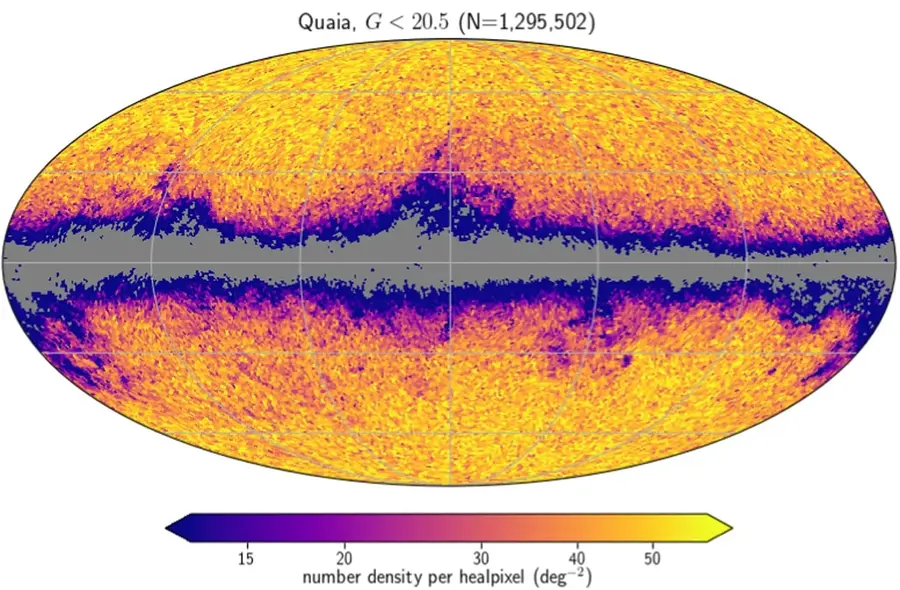The largest map of a million quasars in the universe has been created
- March 19, 2024
- 0
Quaia’s new quasar map covers the entire sky. The light of the most distant objects has been reaching us since the universe was one and a half billion
Quaia’s new quasar map covers the entire sky. The light of the most distant objects has been reaching us since the universe was one and a half billion

Quaia’s new quasar map covers the entire sky. The light of the most distant objects has been reaching us since the universe was one and a half billion years old. The catalog will allow astronomers to study the large-scale structure of the universe.
The main mission of the European Space Agency’s Gaia mission, launched more than 10 years ago, is to compile a detailed map of the Milky Way stars. Because we’re inside our galaxy, this space telescope looks in all directions, so it inevitably picks up more distant light sources. Thus, more than 6.6 million quasar candidates were included in the DR3 catalogue, which is the last catalog published for 2024.
Although Gaia instruments “see” quasars, the active nuclei of distant galaxies, they are not powerful enough to confirm these sources and accurately determine their distances. This selection includes many stars and galaxies that do not have active cores. However, the goal was to create the most complete catalogue, not the most accurate one.
Therefore, an international group of scientists engaged in “cleaning” the data. To do this, the researchers combined Gaia data with data from the unWISE catalog of the WISE Wide-Angle Infrared Space Telescope. They then filtered sources that could be quasars by parameters and supplemented the database with precise spectral data from the Sloan survey. According to the authors of the new study, they managed to reduce the number of pollutants by about fourfold.
“This is not the catalog with the largest number of quasars, and it is not the catalog with the most accurate quasar observation data. Instead, it is a catalog covering the largest volume of the universe,” explained one of the co-authors, David Hogg, professor of physics and data science at New York University (USA).
The new Quaia catalog includes 1.296 million quasar candidates. It covers the entire sky except the galactic plane of the Milky Way. Regions near the Large and Small Magellanic Cloud galaxies, moons of the Milky Way, are also not visible very well. However, this is the first time the southern hemisphere has been fully represented on the map. Additionally, based on the collected data, the authors of the new catalog created a map of the distribution of dust, stars and other cosmic objects that could obscure or suppress the light of distant quasars.
Quasars are the bright cores of galaxies where the central supermassive black hole is actively absorbing matter. This process is closely related to the evolution of the galaxy. This is why quasars attract the attention of astronomers. With the help of these space objects it is possible to study the evolution and halo of galaxies, the accumulation of mass of supermassive black holes and their impact on the surrounding space.
Quasars are usually found in regions where dark matter is most dense; They can be used to study the map, properties and evolution of the cosmic web, to test hypotheses about the homogeneity and isotropic nature of the universe. By analyzing the light of quasars it is possible to study the composition and structure of intergalactic space. They are also used as “standard candles” in calculating the expansion rate of the universe.
An article describing the catalog creation process was published in the magazine Astrophysical Journal. The catalog itself is publicly available.
The list of known quasars will soon be joined by spectral data for three million quasars from the DESI survey and data from the Vera Rubin Observatory, which is expected to detect more than 10 million quasar candidates. But neither that nor the other survey will have a map of the entire sky with accurate data on the redshift (i.e. distance) of objects. This is why the Quaia catalog is so valuable, and we should expect a lot of research based on the analysis of its data.
Source: Port Altele
As an experienced journalist and author, Mary has been reporting on the latest news and trends for over 5 years. With a passion for uncovering the stories behind the headlines, Mary has earned a reputation as a trusted voice in the world of journalism. Her writing style is insightful, engaging and thought-provoking, as she takes a deep dive into the most pressing issues of our time.